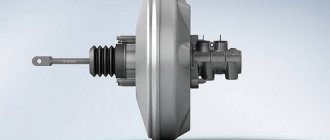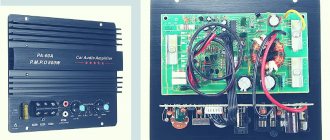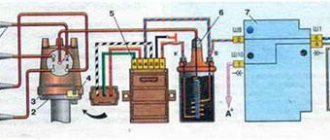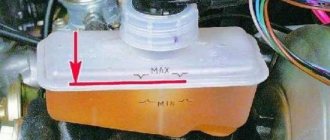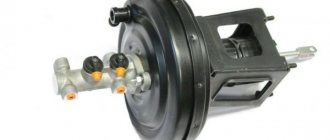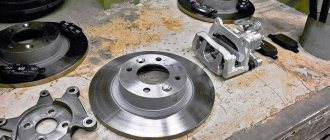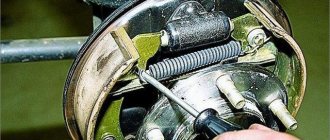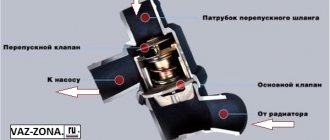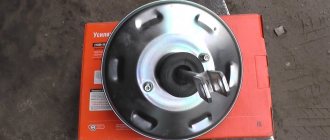Repair of vacuum brake booster VAZ 2109
The main sign indicating to the driver that the vacuum booster is faulty is difficult movement of the brake pedal, which in turn affects the quality of braking and, as a consequence, the safety of driving. Vacuum amplifiers can only be repaired using special equipment; if you don’t have such equipment, you will have to replace it completely, but before that you need to check the quality of its operation and the operation of the check valve, and only after that make a decision about either replacement or repair.
To check the operation of the vacuum booster, press the brake pedal several times, creating pressure in the system, and the brake pedal should lock in the upper position. Now, without releasing the pedal, start the engine. At the moment of startup, if the amplifier is working properly and the tightness of the connection of the vacuum hoses is not broken, the pedal will go down. If it does not go down, then first of all we check the quality of the connection of the vacuum hose and the tightness of the check valve.
To check the check valve on a VAZ 2109 car, you need to do the following sequence of actions:
- First of all, as mentioned above, we check the tightness of the connection of the hoses with the fitting on the inlet pipe and the check valve on the amplifier.
- Next, you can start checking the valve itself, first disconnect the hose from it and pry it off with a flat screwdriver, remove it from the amplifier.
- In the next step, we will need any rubber bulb, the only two conditions: the bulb must be sealed and it must fit the diameter of the valve fitting. A hydrometer is quite suitable for this role.
- Having pulled it onto the fitting, we squeeze the bulb with our hand, thereby releasing air through the valve and releasing it. If the bulb remains compressed, then the valve is working properly, that is, it holds the vacuum. Otherwise, it must be replaced. As an option, you can try to blow out the valve with your mouth, that is, first we blow it out, so the air should come out freely, and then we suck it in and, as a result, the air should not pass through.
This completes the process of checking the vacuum booster and check valve of the VAZ 2109. If the tightness of the hoses is not broken, and the valve itself is working properly, then you will have to change the amplifier.
Examination
Replacing the vacuum brake booster of a VAZ 2109
Vacuum booster repairs are carried out in specialized auto repair shops using equipment designed for this purpose. In the context of garage repairs on a VAZ-2109, the vacuum brake booster is replaced with the installation of a new one. Before making a decision to replace, it is necessary to check the operation of it itself, as well as the check valve.
Checking the operation of the vacuum booster
VAZ 2109 vacuum brake
To check the operation of the amplifier you need to:
- Press the pedal with your foot, thereby increasing the pressure in the brake system. The pedal remains depressed.
- Keep your foot on the pedal and turn on the engine.
- When you start the engine, the foot with the pedal begins to move towards the floor of the VAZ body, which means that the vacuum booster is working and the entire system is in good working order.
Note. In another case, the foot and pedal remain motionless, that is, in the upper depressed state, which means there is a malfunction somewhere. First you need to check the vacuum hose at the connections. Also check the check valve for leaks.
Check valve
VAZ 2109 vacuum brakes
To check the operation of the check valve:
- inspect the pipe connections;
- feel these places with your hands;
- tighten the clamps at the connections of the pipes;
- on the intake pipe fitting;
- on the non-return valve fitting, on vacuum.
Then check the valve itself. To do this, remove the rubber tube from the vacuum, using a flat-head screwdriver if necessary. Since the tube is very difficult to remove. Take a pre-prepared rubber bulb-shaped injector of suitable diameter for the fitting:
- Paste it;
- Squeeze the syringe;
- Squeeze the air out of it.
Release your hand if it remains clenched then the valve test is complete. That is, the valve fulfills its design purpose. If the injector is filled with air, then the valve will have to be replaced. You can also check the operation of the valve with your mouth:
- Blow the air out of your mouth; it should easily pass into the vacuum;
- Then apply suction; the air coming out should not be felt.
This completes the check of the brake system vacuum booster and check valve. If no defects are found in the connected parts and the check valve is working properly, the vacuum is replaced.
Node examination
The need to replace the vacuum booster on a VAZ 2109 should already be stated in the event of an increase in the force applied to the brake pedal. However, a simple check will help ensure the correctness of the diagnosis:
- turn off the engine;
- press the brake pedal 5-6 times;
- hold down the brake pedal;
- start the engine.
The identifier of a serviceable VUT is an immediate, noticeable movement of the brake lever forward.
An alternative symptom will help diagnose a unit malfunction: when the engine is running, a “hissing” can be heard under the hood in the area where the intake manifold pipeline connects to the VUT check valve fitting. Experienced specialists additionally prefer to check:
integrity of the suitable pipe; tight fit of the main element on the fitting (hissing may appear as a result of a loose connection). The initial stage of failure of the vacuum booster is especially clearly identified on “nines” with a carburetor power system. The brake pedal is activated, as expected, with a light force, braking is good and informative, but:
- at idle speed the engine “troits”;
- when you press the brake pedal, the idle speed stabilizes;
- after applying pressure to the accelerator in neutral gear, “dips” occur, regardless of carburetor adjustments.
If the symptoms described above are present, it is advisable to remove the pipe from the “vacuum manifold” fitting with the engine running and plug the hose with a suitable object or finger - the idle speed has returned to normal and, therefore, replacing the vacuum booster on the VAZ 2109 is inevitable. If a malfunction is detected along the way in this way, the movement should be continued with the VUT turned off: the pedal will be hard, but the information content will remain.
How to replace a defective vacuum booster on a VAZ 2109: list of actions
The initial task of repair is to disconnect the pedal from the amplifier rod. Dismantling is carried out in the area of the pedal assembly: it is necessary to disconnect the two units connected to each other by a pinned pin using a flat-head screwdriver.
Further work is carried out in the engine compartment:
- disconnect the power supply connector for the brake fluid level sensor;
- dismantle the bracket that secures the hydraulic lines relative to the car frame (unscrew the nut with a head to “10”);
- disconnect the main brake cylinder by unscrewing the two nuts securing it to the VUT using a 17" wrench.
Note. When changing the brake booster, do not disconnect the hydraulic lines from the master cylinder. The lengths of the pipes make it possible to move the unit outside the working area.
After access to VUT is opened, the plan for replacing the vacuum booster of the VAZ 2109 brake system comes into force, including the following measures:
- disconnect the pipe connecting the amplifier chamber to the intake manifold;
- remove the front strut strut (installed additionally);
- unscrew the four nuts that secure the amplifier housing to the body studs (use a set of wrenches + extension + universal joint + head on “13”);
- remove the assembly from the studs and remove it from the engine compartment.
On the back side of the amplifier (on the drive fork side) a seal is installed and a bracket is attached, through which the unit is connected to four studs on the car frame.
The parts must be dismantled: it is enough to unscrew the two fastening nuts with a “17” head and remove the iron structure by moving it towards you. The boot is easily pulled off the stem. Having mounted the mounting bracket and rubber seal on the new amplifier, you can begin installing the VUT, which proceeds according to the reverse scenario. When installing, you should pay attention to three facts:
- The vacuum booster rod should be connected to the brake pedal immediately after the unit is seated on the mounting studs (before tightening with nuts);
- experienced owners additionally apply sealant between the brake cylinder and the VUT, indicating the imperfection of the sealing elements;
- the VUT rod acting on the main brake cylinder (located on the front side of the housing) may move during transportation or installation (it is necessary to check and, if necessary, install correctly by pressing until it stops).
For your information. An incorrectly installed actuator rod will result in the brakes not working after assembly.
Replacement
VAZ 2109 vacuum brake booster
To do this, you need a simple set of keys:
The repair is carried out in the garage, where the hood should be raised and a support installed.
Removing the vacuum
Sequence of work:
- remove the negative terminal from the battery;
- disconnect the rubber tube from the brake vacuum, first unscrew the clamp;
- disconnect the electrical power supply terminal for the level sensor from the brake master cylinder cover;
VAZ 2109 checking the vacuum brake booster
- then, inside the car, move the driver’s seat to the farthest position, as far as the runners will allow;
- lower under the steering column towards the brake pedal.
Note: if necessary due to lack of lighting, use a portable lamp with a safety flashlight.
- Using pliers, remove the locking ring from the sleeve that connects the pedal itself to the vacuum rod connector;
- remove the rod, lower it to the floor of the body.
Note: the rod connector is a U-shaped plate with holes for attaching to the pedal bar.
- return to the set vacuum;
- Now you have to carefully remove the brake master cylinder;
Checking status
The corresponding signs may indicate the need to change the vacuum booster or the brake master cylinder.
The primary sign of VUT failure is an increase in the force that must be applied to the pedal to brake.
To be sure of the problem, perform the following check:
- Turn off the engine;
- Press the brake pedal 5-6 times in a row;
- Press the pedal to the floor;
- Start the engine;
- If the VUT is working properly, the pedal will immediately go up.
- Checking the condition
If you have a VAZ 2109 carburetor engine under the hood, you can determine the VUT malfunction a little differently in the initial stages:
- Initially, the pedal will work normally, you will have to apply a little force, braking occurs normally;
- But at the same time the engine stalls at idle;
- When you press the brake pedal, the idle speed calms down;
- By pressing the gas in neutral gear, failures occur in the carburetor;
- If such symptoms are observed, with the engine running, remove the pipe from the VUT fitting and plug it with your finger or other available tool;
- Has the idle speed stabilized? In this case, replacing the vacuum seal cannot be avoided.
If such a malfunction is detected while driving, you can continue driving only if the VUT is turned off.
Amplifier testing methods
If checking the connections and hose does not show anything, we go directly to the vacuum brake booster. The easiest diagnostic method is to work with the brake pedal.
- Start the engine for 2-3 minutes and turn it off. Press the brake pedal four times and continue to keep your foot on the pedal. Start the engine. When starting, the pedal should gradually move down. Turn off the engine.
- Start the engine and after idling for a while, press the brake pedal and stop the engine. The brake pedal must be kept pressed for 30 seconds after stopping the engine. It must be in the specified position. If the pedal fails, there is a leak in the hose, valve, brake booster or intake manifold.
Press the brake pedal several times with the engine off. If after the second and third press the pedal rises higher, this indicates that the vacuum brake booster is working.
Choice
We will give some recommendations regarding the choice of a new vacuum amplifier.
Selection criterion
Required parameters
The cost of a good vacuum cleaner is now about 2.5 thousand rubles. These are not the most expensive, but not the cheapest Chinese options. Optimal for VAZ 2109
This packaging, used by a genuine manufacturer, is made of corrugated cardboard
The label should be clearly legible - the production batch number, the production date of the part and the name of the manufacturer itself
You should not buy from market traders. There are many good, trusted spare parts stores in any city. Don’t be shy to ask for certificates, documents for parts
Choosing wisely
Now there are a lot of fakes on the market. Such parts cost the same as the originals, but last much less.
Replacement of VUT
First, remember that repairing the vacuum booster is impossible. This unit is removed and replaced with a new one. In theory and in practice, some do. But at your own responsibility.
Now about the replacement itself.
- Disconnect the brake pedal from the booster rod. The units are connected to each other by a pin. Dismantling is carried out in the area of the pedal assembly and here you will need a simple flat-head screwdriver.
- Let's go and open the hood.
- Disconnect the power supply to the brake fluid level sensor.
- Remove the bracket that holds the hydraulic lines to the frame. A 10mm socket is useful, which is used to unscrew the nut.
- Disconnect the brake master cylinder. To do this, unscrew the 2 nuts holding it to the vacuum unit. Assess the condition of the GTZ. If necessary, replace it too.
- It is not necessary to disconnect the hydraulic lines from the brake cylinder (master). The pipes are quite long, so they can easily be moved to the side so that they do not interfere with the work process.
- Disconnect the pipe that connects the vacuum chamber to the intake manifold.
- Remove the spacer from the front struts.
- Unscrew the 4 nuts that hold the vacuum housing to the car body studs.
- Remove the unit from the studs and pull it out through the engine compartment.
- On the drive fork side, there is a seal with a bracket on the return of the amplifier. He secures the assembly to the frame with 4 studs. They need to be removed. To do this, use a 17mm head to remove 2 nuts, after which the iron structure is removed. Just pull it towards you. Be sure to pull the boot off the stem.
- Install the mounting bracket and a new rubber seal onto the new vacuum booster. Now you can begin full reverse assembly.
Replacement
VAZ 2109 vacuum brake booster
To do this, you need a simple set of keys:
The repair is carried out in the garage, where the hood should be raised and a support installed.
Removing the vacuum
Sequence of work:
- remove the negative terminal from the battery;
- disconnect the rubber tube from the brake vacuum, first unscrew the clamp;
- disconnect the electrical power supply terminal for the level sensor from the brake master cylinder cover;
VAZ 2109 checking the vacuum brake booster
- then, inside the car, move the driver’s seat to the farthest position, as far as the runners will allow;
- lower under the steering column towards the brake pedal.
Note: if necessary due to lack of lighting, use a portable lamp with a safety flashlight.
- Using pliers, remove the locking ring from the sleeve that connects the pedal itself to the vacuum rod connector;
- remove the rod, lower it to the floor of the body.
Note: the rod connector is a U-shaped plate with holes for attaching to the pedal bar.
- return to the set vacuum;
- Now you have to carefully remove the brake master cylinder;
VAZ 21093 vacuum brake booster
- it must be removed together with the corresponding brake system pipes.
Note. This must be done so as not to add additional work of filling the brake fluid and pumping the entire brake system to all four calipers.
- clean the threaded connection on the master cylinder bushings and use a metal brush to carry out this work.
Note. Carefully unscrew the nuts, turning them forward and backward several times, so as not to strip the threads on the screws. Remove the nuts from the screws, and also remove the washers that are in a compressed state.
Vacuum brake booster
To make the work easier, use a flat screwdriver to go along the cylinder body and lightly, as carefully as possible, release them from sticking.
Note: if the nuts cannot be unscrewed, you need to drop a few drops of 70% acetic acid on them, wait 30 minutes, clean the threads with a wire brush and repeat unscrewing.
After removing the washers, you need to begin removing the brake master cylinder. It will be difficult to remove. Therefore, you need to be careful, so as not to break or bend the brake pipes too much, to apply force sharply, but not too much. The brake cylinder must be removed forwards, without deviating to the side. The last final step is removing the vacuum. It is attached to the interior partition on a bracket.
- The bracket is attached to two studs; clean the threads as indicated above.
- Unscrew the nuts and remove the vacuum along with the bracket.
Then after removal, unscrew the two blind bolts from the vacuum. Set it aside. Carefully screw the new vacuum to the bracket. Reassemble in reverse order. The price of a vacuum brake booster is 2,500 rubles. When choosing it, you should pay attention to the packaging. Manufacturer's guaranteed packaging must be made of corrugated cardboard.
- manufacturer's name;
- batch number;
- Date of issue;
- The article number must also be indicated: 2108-3510010TM.
Because there are fakes on the market. Therefore, you need to buy from trusted sellers, in stores that have been able to establish themselves on the positive side. When doing the work yourself, you need to watch the video very carefully. The most important thing will be to remember the order of repair work. For a better understanding, take a photo of the repair site. At home, number them in order in advance. Performing work one by one, move the photos down. Don’t be lazy to do this, since during assembly you can check the sequence of correct execution of the process. It also doesn’t hurt to read the instructions for car repairs to avoid unexpected situations.
Reassembly
If you decide to dismantle and reassemble yourself, be sure to follow several recommendations when installing a new VUT:
- The vacuum rod and the brake pedal are connected to each other immediately after the device is seated on the mounting studs. That is, before they started tightening the nuts.;
- Experienced VAZ 2109 owners recommend applying sealant between the vacuum brake booster and the brake cylinder. This is due to imperfect design;
- The vacuum rod, which acts on the main brake cylinder, may move during transportation of the part. Also, displacement often occurs during the installation process. Therefore, be sure to check this fact and install it correctly if necessary. To do this, press the rod all the way. If the stem is not installed correctly during assembly, the brakes simply will not operate properly. The consequences are hardly worth talking about.
Rules mandatory for compliance with the installation of a new VUT
When installing a new vacuum mechanism, consider the following rules:
- the VUT rod is connected to the brake pedal after placing the device on the fixing pins;
- to perfect the sealing components, lubricate the space between the brake cylinder and the vacuum device with sealant;
- the VUT rod in the VAZ-2109, which affects the main brake cylinder located on the front side of the frame, can move during transportation or installation. Therefore, to check the condition of the product, press it all the way.
Determining the correct installation of the vacuum brake booster is not difficult - the brake pedal, if the product is installed correctly, works without failure.
Video instructions on how to replace the vacuum brake booster in a VAZ-2109 with your own hands are presented below:
Master brake cylinder
It is not uncommon to discover problems with the master cylinder when checking the condition of the brake assembly.
When changing the vacuum seal, it would be logical to study the current state of the gas turbine engine and, if necessary, replace it.
The replacement procedure itself is as follows.
- Disconnect the negative terminal from the battery.
- Disconnect the wire block from the fuel oil level sensor. It is located in the tank and is built directly into the lid.
- Use a special wrench for brake pipes to loosen their tension. There is no need to unscrew it completely.
- Unscrew the pair of nuts that secure the GTZ to the vacuum chamber. Only now can the brake pipes be completely unscrewed.
- Remove the cylinder from the studs.
- If necessary, remove the brake fluid reservoir itself at the same time. To do this, you need to carefully rock the tank and remove the leg from the bushing.
- Assess the condition of the removed cylinder. Also be sure to check for any defects on the tank. If there are any, be sure to replace the brake fluid reservoir with a new one.
- Armed with a new GTZ, put it in place and tighten the nuts. Fasteners can be fully tightened immediately.
- Install the reservoir and fill it with brake fluid to the maximum mark.
- Now a very important step is to extract air from the cylinder. To do this, you need to close the holes in the front brake pipes with your fingers. At the same time, your assistant should gently, but not sharply, press the brake pedal. This will create pressure in the system. Continue this manipulation until you feel liquid coming out of the holes.
- As soon as the liquid flows, put on the tubes, install and fix them in place. In this case, the brake pedal cannot be released.
- By analogy, the rear tubes are connected. When they are installed in place, there must be pressure in the system, that is, the brake pedal is pressed to the floor.
After completing the replacement of the turbocharger, do not forget to bleed the brake system according to the rules.
It is quite possible to change the vacuum seal and cylinder with your own hands. The work will take a few hours, but will save a lot of money on visiting a car service center.
Vacuum pump device
The design of a vacuum pump is not much different from other types of equipment in this category, but the principle of its operation is different. This type of unit creates a vacuum environment by displacing an air mass under low pressure.
A sealed working space is created by the working parts of the pumping unit and allows you to perform a wide range of work in the industry of pumping liquids or gaseous masses without the risk of leakage. Despite the fact that this type of equipment was originally intended for industrial purposes, today it is also applicable in everyday life.
Vacuum pumps are used in the following industries:
Operating principle of rotary vane vacuum pump
- care for the environment - such installations are equipped with cleaning and filtration systems;
- food industry – production of vacuum packaging;
- production of medical equipment - systems for pumping saliva, blood, components for life support devices;
- chemical and petrochemical industry – pumping and distillation of aggressive liquids;
- production of glass and ceramics;
- creation of a water supply system in a summer cottage or suburban area.
Efficiency of use
The VAZ 2109 model was one of the first domestic cars to receive such a unit as standard equipment (before that, not all cars were equipped with an amplifier). This innovation has significantly improved the efficiency of driving and reduced its braking distance, regardless of the road surface.
Braking efficiency with this unit increases on average by 30-40%, depending on the specific model and road conditions.
On video of the VAZ 2109 vacuum brake booster:
Device and application
The brake booster is made in the form of a single block part (round in shape with two rods). Structurally, this block is divided into two unequal parts, each of which performs a specific function.
One side of the amplifier is directly connected to the master cylinder, while the other faces the driver (connects directly to the brake pedal).
The part that faces the brake pedal and ends in a chamber through the rod, which is connected to the rest of the part. Such a chamber is called atmospheric.
Another chamber in the block body is called vacuum.
Each of the cameras performs its own specific function. The atmospheric valve, when the gas pedal is pressed, comes into contact with the atmosphere and builds up pressure, which is why the gas pedal has an easy move.
On video how to check the vacuum brake booster of a VAZ 2109:
In the released position, the valve is at rest and is connected to another part of the amplifier (vacuum chamber). On the opposite side, the vacuum chamber is connected to the brake cylinder through a rod and, when the brake pedal is pressed, creates pressure in the form of vacuum through the valve.
The vacuum is created by a vacuum region through a valve, which in this case is located close to the intake system (intake manifold). Thus, when you press the gas pedal, both chambers interact through the valves, acting on the master brake cylinder and making it easier to control the car.
What is VUT and why is it needed?
To determine the malfunction of the VUT, it makes sense to describe its purpose, operating principle, as well as the effect of the vacuum booster on engine operation. So, the main task of the “vacuum man” is to increase the physical force (usually 3...5 times) applied by the driver to the car’s brake pedal. This is vital because even a very strong person is not able to create enough force in the hydraulic brake system so that all the brake pads are compressed to the required value at the critical moment. This force is created due to rarefaction of air, and the area in the engine intake manifold is used as its source or is pumped by an additional pump.
Structurally, the VUT consists of two chambers - atmospheric (on the driver’s side) and vacuum (on the engine side). The vacuum chamber is connected to the intake manifold using an appropriate pipeline. When you press the brake pedal, the vacuum chamber is connected to the atmospheric chamber using a pusher, which has a so-called tracking valve. Next, the diaphragm is connected to the rod and brake fluid is pumped to the brake cylinders. If there is no force on the brake pedal, then under the influence of the return spring the diaphragm returns to its place, the pressure on the brake fluid weakens, which is why the brake pads move apart and braking stops.
VUT device
In the simplest case, the vacuum brake booster takes vacuum from the intake manifold. To do this, it is connected to it by an appropriate pipeline. However, in many modern cars there are separate vacuum pumps for the vacuum pump. They come in two types. The first is mechanical, it is driven by the engine camshaft. The second is electric and is driven by a separate electric motor. The use of additional pumps not only increases the comfort of using the braking system, but also increases its reliability (for example, in the event of damage and/or depressurization). But still, the pump is only an auxiliary element, and the main vacuum is taken from the intake manifold.
This is interesting: What does blue smoke from the exhaust pipe mean?
Fault diagnosis
Driving without a brake booster is at least dangerous, since the braking distance is structurally calculated taking into account the operation of this unit. If it malfunctions, this indicator significantly worsens, the driver loses control over the behavior of the car, which in many cases leads to traffic accidents.
Therefore, diagnosing and timely replacement of this unit is the responsibility of every conscientious driver.
Diagnosing a faulty vacuum brake booster is not a complicated procedure.
Even while driving, there is a uniform method for checking functionality:
- If, when moving at any speed, the gas pedal is very tight, there is a clear problem with this particular unit. Failure can be caused either by a design defect in the unit itself (manufacturing defects) or by mechanical damage (failure of operating valves, breakage of one of the diaphragms);
- The deterioration of the braking properties of the car in this case, when the brake booster breaks down, the effect of the brake pedal is necessarily reinforced by a significant deterioration in the braking distance in relation to the working version.
Causes of vacuum booster malfunction
The vacuum brake booster and its accompanying elements are fairly simple devices, so experts identify the following main and possible malfunctions of the VUT:
- Depressurization of the vacuum pipeline . It creates a vacuum necessary for normal operation of the braking system. Accordingly, if air is sucked into it from the outside, the VUT will not work. Depressurization (air leakage) due to old rubber can occur in a variety of places - in rubber hoses, joints, clamps.
- Check valve malfunction . Its task is to remove air from the brake system and prevent it from entering both the system itself and the master brake cylinder. The valve itself may be faulty, for example, due to natural wear, or due to significant wear of its rubber seals.
- Depressurization of the working chambers of the vacuum amplifier . This is a fairly rare cause, which most often occurs due to mechanical damage to the VUT. For example, during repairs or an accident.
- Diaphragm rupture . This is a critical failure, since it occurs inside the amplifier itself, and it is usually irreparable and, accordingly, must be replaced. In this case, the amplifier will poison the air and emit a hissing sound.
- Formation of an additional gap in the VUT . The fact is that as a result of the operation of the car and, in particular, the mounting mechanism of the vacuum booster, its membrane moves slightly forward, which actually makes it easier for the driver to press the brake pedal. However, as a result of this, an extra gap appears in the mount, which can sometimes cause a knocking noise during heavy braking. To solve this problem, simply adjust the rod by moving it forward a little. Such repairs are possible both in a garage and in a car service center.
If the car is equipped with an additional vacuum pump, then a fourth fault is usually identified - partial or complete failure of this unit. In this case, the brake system itself will work, but not in optimal mode. In particular, during sharp braking, the force that the driver will need to physically exert on the pedal will increase significantly.
Replacement and cost
In any situation when a breakdown is detected, timely replacement of the entire assembly is necessary. It is possible to correct some shortcomings in the form of replacing the valve, but this procedure may not bring a lasting effect, since the part itself in many cases (if we talk about the VAZ 2109 model) must be replaced due to its advanced age. After installing a new part, be sure to make adjustments.
Breakdowns of vacuum amplifiers do not happen so often with this model, however, due to their age (production of the model was discontinued in 2004), the amplifiers gradually wear out and become unusable over time.
On video of a malfunction of the vacuum booster:
There are many suppliers of parts for VAZ cars on the market. The average price (cost) of a new amplifier is about 2000 rubles.
Checking the vacuum brake booster VAZ 2109
Often, if the braking of a VAZ 2109 car is ineffective, it becomes necessary to check the vacuum brake booster.
The very name of this unit speaks about its purpose: with the help of a vacuum, the effect on the main brake cylinder from the brake pedal is enhanced. So, if you need to press the pedal very hard to make the car brake, you need to check the vacuum booster. Checking the vacuum brake booster of the VAZ 2109 is as follows:
- With the engine not running, press the brake pedal and hold it with your foot.
Press the brake pedal
The pedal presses on the VUT rod
When the VAZ 2109 engine is not started, the vacuum booster is not yet working. Just for fun, try coasting down a hill with the engine not running. It becomes much harder to brake. This is something to keep in mind when you are being towed: you need to start braking early.
- Turn on the ignition and start the car, the brake pedal should fall down a little.
Why? But because when the engine is running, a vacuum is created in the intake manifold of the VAZ 2109, which, through a hose with a check valve, increases the pressure on the pedal. Vacuum from the engine intake manifold helps push the brake pedal.
- If at the moment when the engine started the brake pedal did not go down, then the vacuum brake booster of the VAZ 2109 is faulty and must be replaced. However, before you run to the store to buy a new one, you need to check the hose from the brake booster to the intake manifold. The check valve must also be checked.
Check valve VAZ 2109
Checking the hose comes down to checking that the clamps are securely fastened and that there are no cracks in the hose itself.
Attaching the hose to the manifold
If there is an air leak through the vacuum brake booster hose, the VAZ 2109 will stall at idle. If you're lucky, you can even hear the air leak. The characteristic hiss of air sucked into the hose will indicate a leak. The check valve is a simple thing; it can also be checked easily. For some reason, all repair and operating instructions for the VAZ 2109 recommend checking the check valve using a special bulb. For example, I don’t have it, but I need to check it. Therefore, simply checking is done with your mouth. That's the whole point. The valve only allows air to flow in one direction: into the intake manifold; it should not allow air to flow back. We remove the valve and suck in air through it: air should be sucked in from the manifold side, but not from the VUT side. That's the whole test.
Didn't find the information you are looking for? on our forum.
Examination
Replacing the vacuum brake booster of a VAZ 2109
Vacuum booster repairs are carried out in specialized auto repair shops using equipment designed for this purpose. In the context of garage repairs on a VAZ-2109, the vacuum brake booster is replaced with the installation of a new one. Before making a decision to replace, it is necessary to check the operation of it itself, as well as the check valve.
Checking the operation of the vacuum booster
VAZ 2109 vacuum brake
To check the operation of the amplifier you need to:
- Press the pedal with your foot, thereby increasing the pressure in the brake system. The pedal remains depressed.
- Keep your foot on the pedal and turn on the engine.
- When you start the engine, the foot with the pedal begins to move towards the floor of the VAZ body, which means that the vacuum booster is working and the entire system is in good working order.
Note. In another case, the foot and pedal remain motionless, that is, in the upper depressed state, which means there is a malfunction somewhere. First you need to check the vacuum hose at the connections. Also check the check valve for leaks.
Check valve
VAZ 2109 vacuum brakes
To check the operation of the check valve:
- inspect the pipe connections;
- feel these places with your hands;
- tighten the clamps at the connections of the pipes;
- on the intake pipe fitting;
- on the non-return valve fitting, on vacuum.
Then check the valve itself. To do this, remove the rubber tube from the vacuum, using a flat-head screwdriver if necessary. Since the tube is very difficult to remove. Take a pre-prepared rubber bulb-shaped injector of suitable diameter for the fitting:
- Paste it;
- Squeeze the syringe;
- Squeeze the air out of it.
Release your hand if it remains clenched then the valve test is complete. That is, the valve fulfills its design purpose. If the injector is filled with air, then the valve will have to be replaced. You can also check the operation of the valve with your mouth:
- Blow the air out of your mouth; it should easily pass into the vacuum;
- Then apply suction; the air coming out should not be felt.
This completes the check of the brake system vacuum booster and check valve. If no defects are found in the connected parts and the check valve is working properly, the vacuum is replaced.
